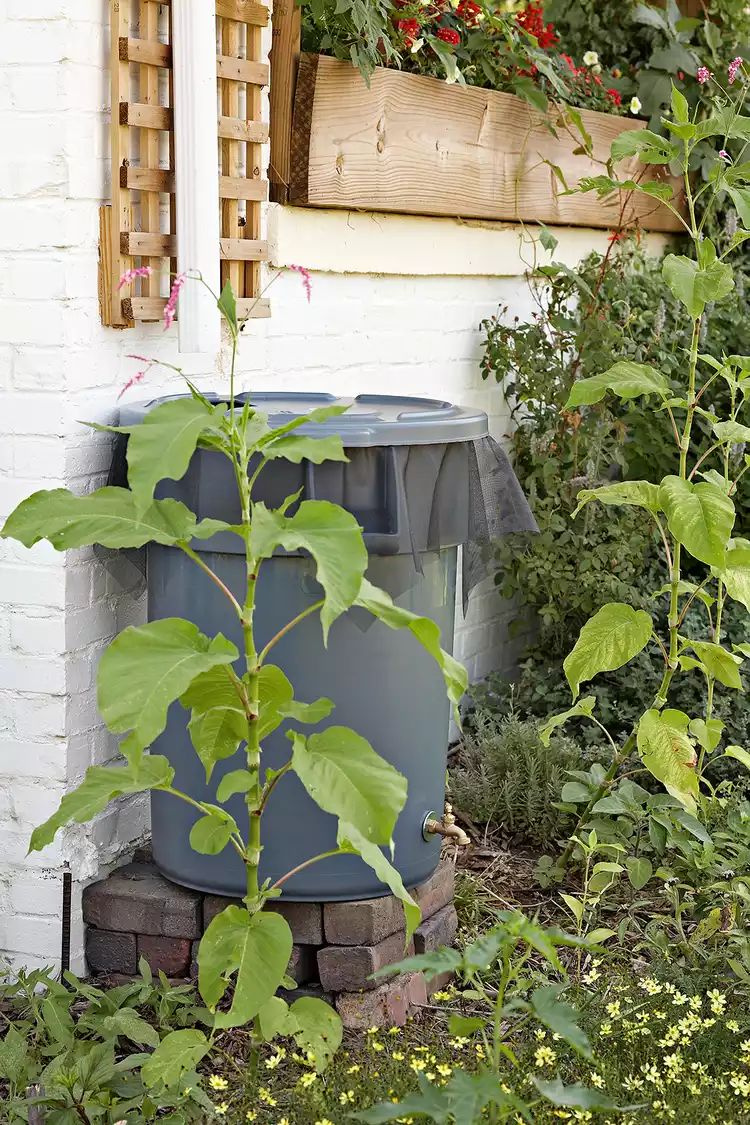Did you know that each inch of rain that falls on 500 square feet of roof equates to about 300 gallons of water? Instead of letting rainwater run off into storm drains, you can collect and store the precious resource in a DIY rain barrel. Besides helping conserve your area's water supply, collected rainwater can be used in your garden to reduce your water bill. Forgo the purchase of an expensive rain barrel—you can construct a DIY rain barrel from an inexpensive outdoor garbage can in just a few hours.
Some states have restrictions on collecting rainwater, so be sure to check your local regulations first.
What You'll Need
With these simple, straightforward steps, anyone can make a DIY rain barrel by upcycling an outdoor trash can. You'll need the following tools and supplies for this garden project:
- 1 plastic outdoor garbage can with lid (the larger it is, the more water you can collect)
- 1 brass spigot
- 1 tube of watertight sealant
- 1 roll of Teflon tape
- 1 threaded pipe union fitting (or 2 rubber washers, 2 metal washers, and 1 nut)
- Power drill and bit
- Box cutter or utility knife
- Landscaping fabric or fine mesh screen
Instructions
Step 1: Drill a Hole
Drill a hole into the side wall of your trash can a few inches above the bottom of the container. This is where you'll insert your spigot. Use a drill bit that's a little smaller than or the same size as the spigot or union fitting (matched to the size of your spigot).
:strip_icc():focal(670x960:672x962):format(webp)/rain-barrel-diy-hole-insert-spigot-washer-AXi8te9Y4nD84JmgKV5t4W-06c9bd99fc19414d955239162e102864.jpg)
:strip_icc():focal(573x633:575x635):format(webp)/rain-barrel-diy-seal-spigot-caulk-washer-7ce4RdlHaKh8l_6VjhV-Ui-1b412483ae744d1fb8e36c6e0ab2cac0.jpg)
Step 2: Attach and Seal the Spigot
Place a metal washer onto the threaded end of the spigot, then put a snugly fitting rubber washer over the threads to help hold the washer in place and prevent leakage. Apply waterproof sealant over your rubber washer and insert the spigot into the hole on the outside wall of your DIY rain barrel. Allow the sealant to dry, then run a rubber washer followed by a metal washer onto the threads of the spigot inside the barrel. Secure the spigot inside your barrel with a nut.
Alternatively, insert the pipe union fitting into the drilled hole, leaving a small gap. Apply sealant to the fitting, then tighten it onto your barrel. Apply more sealant to the fitting's nut and screw it onto the fitting inside the garbage can. Allow the sealant to dry. Wrap the spigot threads with Teflon tape, then screw the spigot into the union fitting on the outside of the barrel.
Step 3: Make Entry and Exit Holes
Carefully cut a hole in the lid of your DIY rain barrel. This hole should sit under your home's downspout so the water runs directly into the barrel. Cut the hole so it's large enough to accommodate the water flow from the downspout. You'll also want to drill a few holes near the very top of your rain barrel—these will allow water to overflow if necessary.
You can run a short length of hose or PVC pipe from the overflow hole to another rain barrel to connect them. If your first rain barrel fills up, the excess water will run into the next one and you won't lose overflow water.
Step 4: Screen the Top
Cut a piece of landscaping fabric or screen to sit over the top of the DIY rain barrel, with at least a couple of inches hanging over the side. Then, put the lid over the top of the container to secure it in place, trimming away excess screen or fabric. This will create a barrier that prevents mosquitoes and other creatures from getting in your collected rainwater. It will also help keep any debris washing off your roof out of your water.
Step 5: Place Your Rain Barrel
Position your DIY rain barrel directly beneath a downspout where it will be most convenient for you to access the spigot. It's best to set your rain barrel on a sturdy platform, such as a low stack of bricks or cinder blocks. This will help gravity push water out of the barrel when using a garden hose attached to the spigot. The added elevation also makes it easier to fill up watering cans directly from the spigot. Then, just wait for it to rain so you can enjoy the water (and money) savings.




















